
West Warwick is a town in Kent County, Rhode Island, United States. The population was 31,012 at the 2020 census.

Fruit of the Loom is an American company that manufactures clothing, particularly casual wear and underwear. The company's world headquarters is in Bowling Green, Kentucky. Since 2002 it has been a subsidiary of Berkshire Hathaway.

Fiskeville is a small village in the south west corner of Cranston, Rhode Island, United States, the south east corner of the Town of Scituate, Rhode Island and across the northern side of Coventry, Rhode Island. The village's Main Street forms the border between Cranston and Scituate. Fiskeville grew up as one of several mill towns along the Pawtuxet River in the mid-1800s. The Fiskeville textile mill was formed by Dr. Caleb Fiske, a Revolutionary War doctor turned businessman in 1812. The village became home to those who worked in the mill, mostly immigrants from Portugal, France, Italy and England. Fiskeville is usually associated with Cranston rather than with Scituate as most of the original buildings including Dr. Fiske's residence were in Cranston. Although the mill and about a dozen nearby mill houses were in Scituate. Poets Karen Haskell and Darcie Dennigan both grew up, a few doors down from each other, in the 1970s and 1980s on Main Street in Fiskeville.

The Pawtuxet River, also known as the Pawtuxet River Main Stem and the Lower Pawtuxet, is a river in the U.S. state of Rhode Island. It flows 12.3 miles (19.8 km) and empties into the upper Narragansett Bay of the Atlantic Ocean. Together with its two main tributary branches, the North Branch Pawtuxet River and the South Branch Pawtuxet River, it drains a watershed of 231.6 square miles (600 km2), all of which is in the state of R.I.

River Point in West Warwick, Rhode Island, United States, is a community made up of mill houses and three mills - the Valley Queen Mill, the Royal Mill and the Cotton Shed. Built in 1834 by the Greene Company, the Valley Queen Mill is the oldest of the three buildings. It originally operated as a cotton factory, producing coarse cotton cloths under the Greene Company name.

The North Branch Pawtuxet River is a river in the U.S. state of Rhode Island. It flows approximately 8.9 miles (14.3 km). There are 9 dams along the river's length.
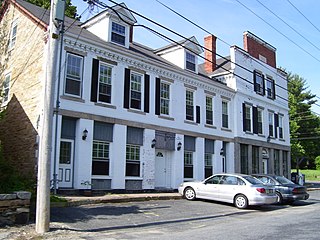
Forestdale is a village and historic district in North Smithfield, Providence County, Rhode Island, United States, one-half mile from Slatersville, Rhode Island. The historic district runs east and west along Main Street and north on Maple Avenue. School Street is the primary road through the village, and the one-room schoolhouse for which the street is named still stands. The Branch River runs through the valley adjacent to the School Street. The Village Haven Restaurant and local VFW chapter are also located in the village.
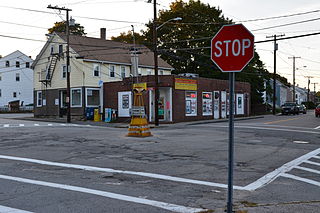
Albion is a village and historic district in Lincoln, Rhode Island, in the United States.

The Ashton Historic District is a historic district in Cumberland, Rhode Island. The district consists of a mill and an adjacent mill village that was built for the workers of the mill. It lies between Mendon Road, Scott Road, Angell Road, Store Hill Road, Front Street and Middle Street. The district was added to the National Register of Historic Places on November 1, 1984.

The Crompton Mill Historic District is a historic district encompassing a mill complex at 20 Remington Street, 53 and 65 Manchester Street in West Warwick, Rhode Island. The mill complex consists of a collection of mainly brick buildings, bounded by the Pawtuxet River and Pulaski, Remington, and Manchester Streets in the village of Crompton. The mill complex formerly extended across the river, but the complex on the west bank was destroyed by fire in 1992. The oldest elements of the complex are the dam site and some of the raceways that provided water power to the mills. The present dam was built in 1908, replacing an 1882 structure. The raceways were built in 1807, around the time of the first mill buildings. The stone Mill No. 1, built 1807, is believed to be the oldest stone mill building in the state. Most of the complex's buildings were built in the late 19th and early 20th centuries by the Providence Manufacturing Company and its successors. The mill was used for textile processing until 1946, when the Crompton Corporation ended production.

The Knight Estate is a historic estate in Warwick, Rhode Island, that is home to the Knight Campus of the Community College of Rhode Island. Developed as a country estate for a family of industrialists and later donated to the state, the main house and its outbuildings were listed on the United States National Register of Historic Places in 1984.
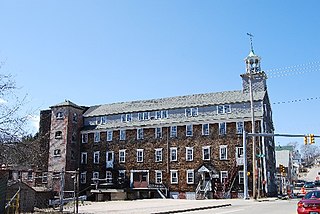
The Lippitt Mill is an historic mill at 825 Main Street in West Warwick, Rhode Island.
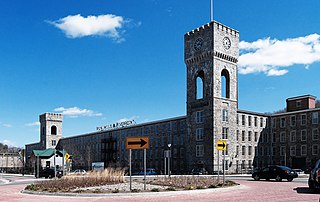
The Royal Mill Complex is an historic textile mill site at 125 Providence Street in West Warwick, Rhode Island. The mill complex was listed on the National Register of Historic Places in 2004. It has recently been completely renovated and remodeled into 250 residential apartments. The complex also includes the Ace Dye Works mill on the south side of the river, which has been converted into lofts. A pedestrian skybridge connects the two mills.

The Valley Queen Mill is an historic mill at 200 Providence Street in West Warwick, Rhode Island.

Robert Knight was a New England industrialist and philanthropist, who was a partner with his brother Benjamin Knight in B. B. & R. Knight and was one of the largest textile manufacturers in the world when he died in 1912. He co-founded the clothing brand Fruit of the Loom, now owned by Warren Buffett's Berkshire Hathaway.

Benjamin Brayton Knight (1813–1898) was a New England industrialist and philanthropist, who was a partner with his brother Robert Knight in the B. B. & R. Knight Company and was one of the largest textile manufacturers in the world when he died in 1898. Knight co-founded the large and famous brand, Fruit of the Loom.

Pontiac is a historic village in Warwick, Rhode Island, and part of the Pawtuxet River Valley.

Lippitt, Rhode Island is a village within the town of West Warwick, Rhode Island.
East Natick is a small village in Warwick, Rhode Island. It is centered on the intersection of Bald Hill Road and East Avenue.
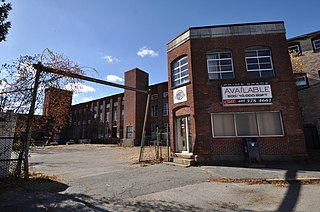
The Lymansville Company Mill is a historic industrial complex at 184 Woonasquatucket Avenue in North Providence, Rhode Island. The oldest portion of the complex, a three-story brick building which originally a textile spinning and carding building, was built in 1884. The mill was significantly expanded in subsequent years, with its last addition taking place in 1951. The Lymansville Company was founded in 1884 and closed in 1957. Auguste Albert Sack, the leading partner in the company, was a German immigrant with significant work experience in New England's textile industry.




















